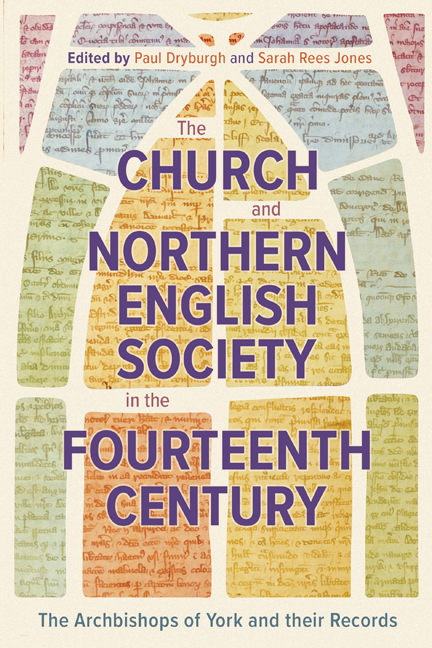 The Church and Northern English Society in the Fourteenth Century
The Church and Northern English Society in the Fourteenth Century Book contents
- Frontmatter
- Dedication
- Contents
- List of Illustrations
- List of Contributors
- Acknowledgements
- List of Abbreviations
- Map: The Ecclesiastical Province of York, c. 1304–1405
- Introduction
- 1 The Administrative Records of the Archbishops of York, 1304–1405
- 2 The Archbishops of York and the Government of Fourteenth-Century England
- 3 Support or Scourge? Archbishop William Melton and the Tradition of Loyal Opposition to the English
- 4 Beyond the Border: The Influence of York Clerks in the Two Edwards’ Scottish Administrations, 1332–1357
- 5 Responding to Royal Requirements: Clerical Taxation in the Province of York, 1304–1405
- 6 Ad insolenciam ipsius rebellis salubrius reprimendam: William Thorntoft, the Abbey of Rufford and Significations of Excommunication in the Northern Province
- 7 Blood, Sex and Holy Water: Reconciling Churches and Churchyards in the Medieval Diocese of York
- 8 Structuring Episcopal Authority: Palaces and Residences of the Archbishop of York
- 9 Medieval Parks of the Archbishops of York
- 10 Northern Ways? Pilgrimage, Politics and Piety in the Fourteenth-Century Administrative Records of the Archdiocese of York
- 11 Underexplored Sources for Gender History: New Approaches to the Fourteenth-Century York Archbishops’ Registers
- 12 Joan of Leeds and other Apostate Nuns in the Province of York, 1300–1350
- Bibliography of Records of the Archbishops of York, 1304–1405
- Index
8 - Structuring Episcopal Authority: Palaces and Residences of the Archbishop of York
Published online by Cambridge University Press: 17 May 2024
- Frontmatter
- Dedication
- Contents
- List of Illustrations
- List of Contributors
- Acknowledgements
- List of Abbreviations
- Map: The Ecclesiastical Province of York, c. 1304–1405
- Introduction
- 1 The Administrative Records of the Archbishops of York, 1304–1405
- 2 The Archbishops of York and the Government of Fourteenth-Century England
- 3 Support or Scourge? Archbishop William Melton and the Tradition of Loyal Opposition to the English
- 4 Beyond the Border: The Influence of York Clerks in the Two Edwards’ Scottish Administrations, 1332–1357
- 5 Responding to Royal Requirements: Clerical Taxation in the Province of York, 1304–1405
- 6 Ad insolenciam ipsius rebellis salubrius reprimendam: William Thorntoft, the Abbey of Rufford and Significations of Excommunication in the Northern Province
- 7 Blood, Sex and Holy Water: Reconciling Churches and Churchyards in the Medieval Diocese of York
- 8 Structuring Episcopal Authority: Palaces and Residences of the Archbishop of York
- 9 Medieval Parks of the Archbishops of York
- 10 Northern Ways? Pilgrimage, Politics and Piety in the Fourteenth-Century Administrative Records of the Archdiocese of York
- 11 Underexplored Sources for Gender History: New Approaches to the Fourteenth-Century York Archbishops’ Registers
- 12 Joan of Leeds and other Apostate Nuns in the Province of York, 1300–1350
- Bibliography of Records of the Archbishops of York, 1304–1405
- Index
Summary
Introduction
The archbishops’ registers can be used as a source of information on buildings and the use of space connected to the role of the archbishop; this information is not as direct and coherent as in building accounts, but it can be recognised and collected by performing a fine-grained analysis of the records. Information on building works in episcopal residences is found in the sections of the registers called ‘Intrinseca Camere’ (‘Inner Chamber’), which concern the secular administration of the archbishop's estate. Information on the use of space by the archbishop and his court can be gathered from other sections in the registers dealing with the spiritual jurisdiction.
Maureen Miller (2000) has demonstrated how palaces and other residences of bishops in Italy structured episcopal authority across a millennium. This theoretical model can be applied in York with coherent results, using the fragmentary information from the registers and the archaeology of buildings (plus further documentary research). After a brief introduction to the types of residences of the archbishop of York, their historical context and their different roles in structuring episcopal authority, this chapter will focus on changes, such as redevelopment and building works, and on the use of space.
In medieval England bishops and archbishops maintained multiple houses. An urban residence next to the cathedral was the episcopal see, while several others were distributed across the territory of the dioceses, located in the countryside and sometimes in towns next to a collegiate church. Each English bishop also had a residence in London that was used occasionally when they attended court at Westminster and to give hospitality to travelling great households, or, indeed, to the king as in the case of York Place, the manor of the archbishop of York that stood at the corner of the present Whitehall and The Strand.
The approach to the study of episcopal residences in England has been framed mainly in terms of their architectural history, with a focus on the origins and development of the form of the palace from the eleventh century onwards and the influence of new continental forms that were imported around the time of the Norman Conquest.
- Type
- Chapter
- Information
- The Church and Northern English Society in the Fourteenth CenturyThe Archbishops of York and their Records, pp. 208 - 224Publisher: Boydell & BrewerPrint publication year: 2024
